A Study of the Impact of Graphite on the Kinetics of SPS in Nano- and Submicron WC-10%Co Powder Compositions
Abstract
1. Introduction
2. Materials and Methods
3. Results
3.1. Sintering of Submicron Powders
3.2. Sintering of Nanopowders
4. Discussion
4.1. Analysis of Kinetics of Isothermal Sintering of Submicron Powders
4.2. Analysis of the Kinetics of Non-Isothermal Sintering of Nano- and Submicron Powders
5. Conclusions
Author Contributions
Funding
Institutional Review Board Statement
Informed Consent Statement
Data Availability Statement
Conflicts of Interest
Appendix A
| Ref. | Hard Alloy | Sintering Mode (1) | Characteristics of Hard Alloys | Initial Powder | |||||||||
|---|---|---|---|---|---|---|---|---|---|---|---|---|---|
| V, °C/min | P, MPa | Ts, °C | ts, min | ρ/ρth, % | XRD Phase Composition | d, μm | Hv, GPa | KIC, MPa⋅m1/2 | |||||
| [13] | WC-11Co | 200 | 25 | 1100 | 5 | ~97 | No data | 0.77 | 92.5 HRA | - | 544 nm (7) | ||
| [14] | WC-8Co | ~25–30 | 10–25 | 1150–1200 | 5–18 | 100 | No data | 0.35 | - | - | 0.12–0.15 μm (7) | ||
| [15] | WC-8Co | 1000 | 60 | 1150 | 65 s | 98.4 | WC, Co | 0.42 | 18.81 | 10.5 (3) | <0.4 μm (7) | ||
| WC-10Co | 98.9 | 0.38 | 17.56 | 11.6 (3) | |||||||||
| WC-12Co | 99.2 | 0.365 | 17.35 | 12.2 (3) | |||||||||
| [16] | WC-10Co | No data | 30 | 1200 | 5 | 98.72 | WC, W2C, Co | 0.7 | 17.19 | - | 0.491% O | ||
| 30 | 1300 | 5 | 99.34 | ~1 | 15.31 | - | |||||||
| [17] | WC-11Co | 100 | 40 | 1250 | 10 | 100 | No data | 0.54 | 18.3 | 11.6 | 200 nm (7), 0.11%Cfree, 0.38%O. | ||
| WC-11Co-0.3VC | 99.8 | - | 18.5 | 12.3 | |||||||||
| WC-11Co-0.5VC | 99.9 | 0.38 | 19.0 | 11.5 | |||||||||
| WC-11Co-0.7VC | 99.6 | 0.38 | 17.0 | 10.5 | |||||||||
| [18] | WC-12Co | 600 | 60 | 1100 | 5 | 97 | No data | ~1 | 22.5 | 15.3 (3) | 40–80 nm (7) | ||
| 1200 | 99 | ~1 | 22.0 | 11.9 (3) | |||||||||
| [19] | WC-10Co | 100 | 100 | 1000 | 10 | 99 | No data | ~0.3 | ~18 | ~12 | 40–100 nm (7) | ||
| [20] | WC-11Co | 100 | 40 | 1200 | 5 | 97.0 | No data | - | - | - | - | ||
| WC-11Co-0.3VC | 97.8 | - | - | - | |||||||||
| WC-11Co-0.5VC | 99.5 | - | - | - | |||||||||
| WC-11Co-0.2Cr3C2 | 97.6 | - | - | - | |||||||||
| WC-11Co-0.4Cr3C2 | 97.5 | - | - | - | |||||||||
| [21] | WC-12Co | 150 | 50 | 1100 | 10 | 99.89 | No data | 0.80 | 14.5 | 10.9 | 0.42 μm (7), 5.32–5.36%C, 0.225%O | ||
| WC-12Co-0.5VC | 97.66 | 0.55 | 14.9 | 10.86 | |||||||||
| WC-12Co-1VC | 95.94 | 0.47 | 15.7 | 11.42 | |||||||||
| WC-12Co-1.5VC | 90.08 | - | 15.87 | 11.43 | |||||||||
| WC-12Co-0.75VC-0.25Cr3C2 | 96.64 | 0.49 | 15.9 | 12.1 | |||||||||
| [22] | WC-10Co (2) | 6 | 60 | 1180 | 10 | 14.57 g/cm3 | No data | 0.48 | 16.43 | 13.1 | 0.8 μm (7) | ||
| [23] | WC-11Co | 100 | 40 | 1200 | 5 | 99.6 | No data | - | - | - | WC: 0.25 μm, 0.38%O, 0.11%Cfree; Co: 60 nm, 0.32%O, Cr3C2: 3.6 μm, 0.22%O, 0.18%Cfree; VC: 2.94 μm, 0.24%O, 0.75%Cfree | ||
| WC-11Co-0.3VC | 99.7 | - | 18.3 | ~12 | |||||||||
| WC-11Co-0.5VC | 99.8 | - | 18.5 | ~11.5 | |||||||||
| WC-11Co-0.7VC | 99.4 | - | - | - | |||||||||
| WC-11Co-0.2Cr3C2 | 99.3 | 0.48 | - | - | |||||||||
| WC-11Co-0.4Cr3C2 | 98.8 | 0.456 | - | - | |||||||||
| WC-11Co-0.6Cr3C2 | 98.6 | 0.435 | - | - | |||||||||
| WC-11Co-0.3VC-0.2Cr3C2 | 99.5 | 0.44 | 18.0 | ~13 | |||||||||
| WC-11Co-0.3VC-0.4Cr3C2 | 98.8 | 0.366 | 18.6 | ~12.2 | |||||||||
| WC-11Co-0.3VC-0.6Cr3C2 | 98.8 | 0.545 | 18.1 | ~12.8 | |||||||||
| WC-11Co-0.5VC-0.2Cr3C2 | 99.6 | 0.41 | 18.6 | ~16.2 | |||||||||
| WC-11Co-0.5VC-0.4Cr3C2 | 99.6 | 0.35 | 19.2 | ~14.2 | |||||||||
| WC-11Co-0.5VC-0.6Cr3C2 | 97.5 | 0.488 | 17.5 | ~14 | |||||||||
| WC-11Co-0.7VC-0.2Cr3C2 | 97.2 | 0.55 | - | - | |||||||||
| WC-11Co-0.7VC-0.4Cr3C2 | - | 0.523 | - | - | |||||||||
| WC-11Co-0.7VC-0.6Cr3C2 | 98.0 | - | - | - | |||||||||
| [24] | WC-12Co | 100 | 60 | 1240 | - | - | No data | 0.28 | 15.69 | ~9.4 (4) | 0.18 μm (7), 6.16%C, 0.09%Cfree | ||
| WC-12Co-0.9NbC | 0.26 | ~16.4 | ~8.8 (4) | ||||||||||
| WC-12Co-0.9Cr3C2 | 0.22 | ~16.5 | ~10.1 (4) | ||||||||||
| WC-12Co-0.9VC | 0.18 | 17.26 | ~9.2 (4) | ||||||||||
| [25] | WC-10Co | - | 60 | 1150 | 10 | ~98.7 | No data | ~0.17 | 87 HRA | ~6 | 0.2 μm (7). Co: 28 nm | ||
| ~97.8 | ~0.23 | 94.5 HRA | 13.5 | 0.2 μm (7) Co: 45 μm | |||||||||
| [26] | WC-12Co | 100 | 60 | 1240 | 2 | 98.9 | No data | 0.27 | 15.5 | - | 0.18 μm(7), 6.16%C, 0.09%Cfree | ||
| WC-12Co-0.9VC | 98.5 | 0.17 | ~17 | - | |||||||||
| [27] | WC-10Co | - | 30 | 1200 | - | 95.7 | No data | - | - | - | 200 nm (7) | ||
| [28] | WC-12Co | 100 | 100 | 1100 | 5 | 100 | WC, Co, W3Co3C, W6Co6C | ~0.30 | ~18.8 | ~9.0 (4) | 91 nm (7) | ||
| 100 | ~0.37 | ~18.3 | ~8.9 (4) | 47 nm (7) | |||||||||
| 100 | ~0.39 | ~17.8 | ~9.3 (4) | 127 nm (7) | |||||||||
| [29] | WC-12Co-0.8C | 100 | 80 | 1100 | 5 | 99.94 | WC, Co | 0.216 | ~18.3 | ~10.6 (4) | 40–80 nm(7) | ||
| WC-12Co-0.8C-1Cr3C2 | 99.79 | 0.207 | ~18.6 | ~10.4 (4) | |||||||||
| WC-12Co-0.8C-1VC | 98.95 | 0.154 | ~20 | ~10 (4) | |||||||||
| [30] | WC-12Co-0.8C | 100 | 80 | 1100 | 5 | 99.94 | No data | 0.216 | 20.4 | 9.1 | 30–80 nm (7) | ||
| WC-12Co-0.8C-1Cr3C2 | 99.74 | 0.207 | 20.1 | 9.3 | |||||||||
| WC-12Co-0.8C-1VC | 98.95 | 0.154 | 19.6 | 10.4 | |||||||||
| WC-12Co-0.8C-0.5Cr3C2–0.5VC | 99.15 | 0.190 | 19.8 | 9.5 | |||||||||
| WC-12Co-0.8C | 95.56 | 0.248 | 20.3 | 8.5 | |||||||||
| WC-12Co-0.8C-0.5Cr3C2 | 98.18 | 0.240 | 19.9 | 8.8 | |||||||||
| WC-12Co-0.8C-0.5VC | 97.99 | 0.235 | 19.4 | 9.0 | |||||||||
| [31] | WC-12Co | 100 | 50 | 1150 | 6 | 99.8 | No data | 1.02 | 14.17 | 10.9 | |||
| WC-12Co-1.3Y2O3 | 99.7 | 0.98 | 14.47 | 11.9 | |||||||||
| [32] | WC-10Co- -0.2VC-0.8Cr3C2 | SPS | 100 | 60 | 1160 | 10 | 14.54 g/cm3 | WC-Co, Co6W6C | 0.35 | 17.07 | 12.1 | 90 nm (7), 5.61%C,0.19%O, 0.19%Cfree | |
| HIP | 8 | - | 1420 | 60 | 14.50 g/cm3 | 0.50 | 15.43 | 13.6 | |||||
| [33] | WC-10Co | 100 | 60 | 1150 | 0 | 98.0 | WC-Co | 0.085 | 20.5 | 11.13 | - | ||
| [34] | WC-10Co-5TiC | 85–90 | 57.3 | 1200 | 13 | 100 | WC, Co, TiC | 1.2 | 14.84 | - | 0.45–0.9 μm (+ 5% 0.1–0.15μm) (7) | ||
| [35,36] | WC-8Co | 100 | 70 | 1250 | 5 | 14.4 g/cm3 | WC, Co | 0.20 | 21.1 | 10.4 | 60 nm (7). 6.13%C, 0.09%O | ||
| [37] | WC-3Co | 400 | 80 | 1400 | - | 97.1 | WC, Co | - | 19.4 | 8.8 | - | ||
| WC-6Co | 97.6 | - | 17.9 | 9.1 | |||||||||
| WC-9Co | 98.1 | - | 16.4 | 9.8 | |||||||||
| [38,39,40] | WC-4Co | 100 | 30 | 1300 | 5 | 97.6 | No data | 0.227 | 23.20 | 10.45 (5) | 60 nm (7) | ||
| WC-6Co | 97.8 | 0.258 | 21.47 | 11.2 (5) | |||||||||
| WC-8Co | 98.0 | 0.314 | 19.87 | 12.27 (5) | |||||||||
| WC-10Co | 98.5 | 0.356 | 18.32 | 13.16 (5) | |||||||||
| WC-12Co | 98.6 | 0.362 | 17.79 | 13.69 (5) | |||||||||
| WC-14Co | 98.6 | 0.374 | 17.48 | 15.46 (5) | |||||||||
| WC-8Co-0.2VC-1CBN | 1250 | 98.3 | 0.246 | 20.81 | 13.01 (5) | ||||||||
| [41] | WC-8Co | 100 | 70 | 1350 | 5 | - | WC, Co | 0.28 | 19.7 | 11.5 (6) | 60 nm (7) | ||
| WC-8Co-0.4VC | - | 20.8 | 9.7 (6) | ||||||||||
| WC-8Co-0.4Cr3C2 | - | 20.2 | 10.0 (6) | ||||||||||
| WC-8Co-0.4TaC | - | 20.3 | 11.3 (6) | ||||||||||
| WC-8Co-0.8VC | 0.17 | 21.8 | 9.4 (6) | ||||||||||
| WC-8Co-0.8Cr3C2 | 0.23 | 20.2 | 10.4 (6) | ||||||||||
| WC-8Co-0.8TaC | 0.25 | 19.9 | 10.6 (6) | ||||||||||
| WC-8Co-0.4Cr3C2-0.4VC | 0.20 | 21.2 | 10.4 (6) | ||||||||||
| WC-8Co-0.4%TaC-0.4VC | 0.22 | 20.8 | 10.3 (6) | ||||||||||
| WC-8Co-0.4TaC-0.4Cr3C2 | - | 20.6 | 10.9 (6) | ||||||||||
| [42] | WC-8Co | 100 | 40 | 1300 | 5 | 99.42 | WC, Co, Al2O3 | 1.1 | 16.2 | ~12 | 1.54 μm (7), RAl2O3 = 20 nm | ||
| WC-8Co-0.25Al2O3 | 99.18 | 1.0 | 16.9 | ~12.2 | |||||||||
| WC-8Co-0.5Al2O3 | 99.04 | 0.9 | 17.16 | ~12.95 | |||||||||
| WC-8Co-0.75Al2O3 | 98.98 | 0.95 | 16.9 | ~12.1 | |||||||||
| WC-8Co-1Al2O3 | 98.88 | 1.0 | 16.65 | ~11.6 | |||||||||
| [43] | WC-8Co | 100 | 50 | 1300 | 5 | 97.2 | WC | - | 18.26 | 10.63 (6) | 2.71 μm (7) | ||
| [44] | WC-10Co+graphite (3.25%C) | - | 30 | 1050 | 3 | 98.5 | WC, Co | 0.061 | 23.56 | 12.5 (6) | - | ||
| [45] | WC-9Co | 100 | 45 | 1200 | 10 | 93.9 | No data | - | 14.11 | - | 3.5μm (7) | ||
| 50 | 1250 | 92.8 | - | 14.95 | - | 0.1 μm (7) | |||||||
| [46] | WC-10Co-0.2VC-1CBN | 100 | 30 | 1300 | 5 | 98.3 | WC, Co, VC, cBN | ~1 | 20.17 | 12.19 (5) | 60 nm (7) | ||
| WC-10Co-0.2VC-5CBN | 96.3 | - | 18.33 | 11.93 (5) | |||||||||
| WC-10Co-0.2VC-9CBN | 89.1 | - | 11.58 | 10.25 (5) | |||||||||
| WC-10Co-0.5VC-1CBN | 97.4 | - | 19.87 | 11.82 (5) | |||||||||
| WC-10Co-0.5VC-5CBN | 94.1 | - | 16.26 | 11.48 (5) | |||||||||
| WC-10Co-0.5VC-9CBN | 90.0 | - | 11.11 | 10.13 (5) | |||||||||
| WC-10Co-0.8VC-1CBN | 96.8 | - | 20.48 | 11.78 (5) | |||||||||
| WC-10Co-0.8VC-5CBN | 94.0 | - | 15.22 | 10.34 (5) | |||||||||
| WC-10Co-0.8VC-9CBN | 89.3 | - | 10.75 | 9.80 (5) | |||||||||
| [47] | WC-8%Co | 100 | 40 | 1250 | 5 | WC, Co | 60 nm (7) | ||||||
| - ultrasonic vibration method | 99.1 | 0.28 | 18.8 | 11.4 (6) | |||||||||
| - ball-milling method (12 h) | 97.1 | 0.35 | 18.1 | 11.7 (6) | |||||||||
| - ball-milling method (24 h) | 94.6 | 0.42 | 17.7 | 10.5 (6) | |||||||||
| [48] | WC-10Co | 50 | 50 | 1300 | 10 | 99.27 | WC, Co | - | 13.0 | 12.97 | <1 μm (7) | ||
| [49] | WC-8Co | SPS | - | 50 | 1200 | 5 | - | No data | ~1 | 13.5 | 16.46 | - | |
| Sinter-HIP | 6 | 1500 | - | - | ~0.5 | 18.73 | 12.09 | ||||||
| [50] | WC-12Co | 100 | 50 | 1200 | 5 | ~98.1 | WC, Co, CeO2 | 0.34 | 18.7 | 12.5 | 200 nm (7), RCeO2 = 10 nm 0.11%Cfree | ||
| WC-12Co-0.05CeO2 | ~98.6 | 0.27 | 19.05 | 13.4 | |||||||||
| WC-12Co-0.1CeO2 | ~99.5 | 0.22 | 19.98 | 14.4 | |||||||||
| WC-12Co-0.3CeO2 | ~98.2 | 0.23 | 19.62 | 14.3 | |||||||||
| WC-12Co-0.6CeO2 | ~98.0 | 0.23 | 19.1 | 12.9 | |||||||||
| [51] | WC-12Co | 100 | 80 | 1100 | 5 | 99.9 | WC, Co | 0.216 | 18.47 | - | 40–80 nm (7) | ||
| WC-12Co-1Cr3C2 | 99.8 | 0.207 | 18.72 | - | |||||||||
| WC-12Co-0.5Cr3C2-0.5VC | 99.2 | 0.19 | 19.23 | - | |||||||||
| WC-12Co-1VC | 98.9 | 0.154 | 19.98 | - | |||||||||
| [52] | WC-10Co-0.86VC | 100 | 60 | 1150 | 0 | - | WC, Co, VC, Co3W3C | 0.127 | 19.6 | 10.2 | - | ||
| WC-10Co-1.15VC | 0.123 | 19.3 | 9.9 | ||||||||||
| WC-10Co-2VC | 0.102 | 20.2 | 9.7 | ||||||||||
| WC-10Co-5VC | 0.097 | 21.0 | 9.0 | ||||||||||
| WC-10Co-10VC | 0.097 | 18.46 | 8.0 | ||||||||||
| [53] | WC-12Co | 50 | 79.6 | 1220 | 3 | 96.9 | WC, Co | 0.192 | ~15 | ~9 | SBET = 3.932m2/g (7) | ||
| 100 | 63.7 | 1250 | 5 | 97.1 | 0.182 | ~15.4 | ~9 | ||||||
| 400 | 79.6 | 1300 | 1 | 95.5 | 0.194 | ~13.5 | ~9.2 | ||||||
| [54] | WC-12%Co | - | - | 1250 | 5 | 99.8 | No data | 0.195 | 16.7 | 10.6 | - | ||
| [55] | WC-9Co-0.6VC | 100 | 50 | 1200 | - | 98.83 | No data | 0.042 | 13.76 | 13.0 | 3.5 μm (7) | ||
| WC-9Co-0.6Cr3C2 | 1200 | 99.15 | 0.036 | 14.59 | 12.3 | ||||||||
| WC-9Co-0.6VC | 1200 | 97.47 | 0.02 | 8.52 | 11.23 | 10 nm (7) | |||||||
| 1300 | 98.43 | 0.042 | 6.05 | 10.25 | |||||||||
| WC-9Co-0.6Cr3C2 | 1200 | 97.54 | 0.019 | 8.0 | 9.0 | ||||||||
| 1300 | 98.36 | 0.039 | 14.45 | 13.15 | |||||||||
| WC-12Co-0.6VC | 1200 | 98.35 | 0.037 | 9.57 | 9.41 | ||||||||
| 1300 | 98.78 | 0.065 | 14.32 | 8.53 | |||||||||
| WC-12Co-0.6Cr3C2 | 1200 | 97.55 | 0.071 | 3.12 | 10.15 | ||||||||
| 1300 | 99.13 | 0.071 | 15.2 | 9.23 | |||||||||
| [56] | WC-5Co | - | 50 | 1400 | 10 | 98 | No data | - | 13.71 | - | 300 nm (7), “core WC—shell Co” | ||
| 1450 | 98 | - | 12.78 | - | |||||||||
| WC-10Co | - | 1400 | 10 | 97 | - | 12.72 | - | ||||||
| 1450 | 96 | - | 13.49 | - | |||||||||
| [57] | WC-12Co | 100 | 60 | 1250 | 10 | 98.2 | WC, Co | 0.22- 0.591 | 19.8- 23.6 | - | - | ||
| [58] | WC-12Co | 106 | 50 | 1130 | 5 | 13.8 g/cm3 | WC, Co | 2.22 | 13.19 | 14.6 | 2.3 μm (7) | ||
Appendix B
Investigation of Uniformity of the Phase Composition of the WC-10Co Hard Alloys Obtained by SPS

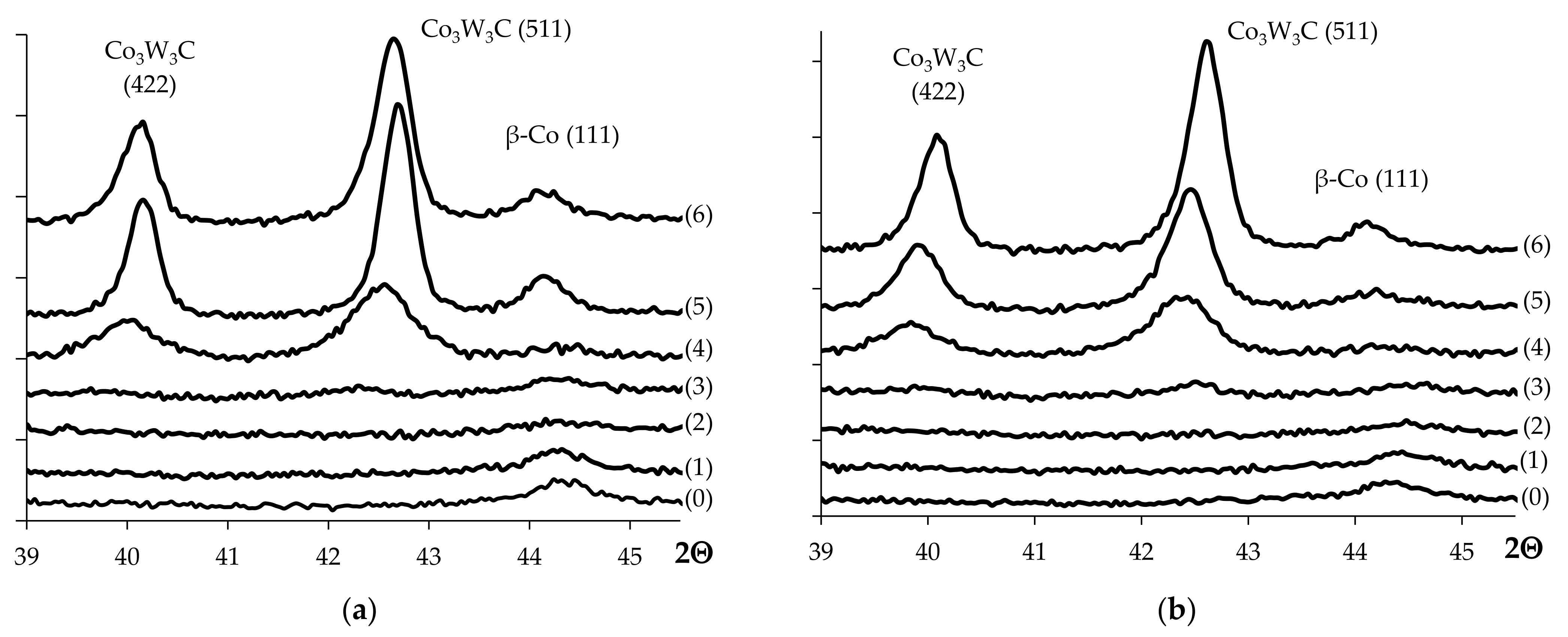
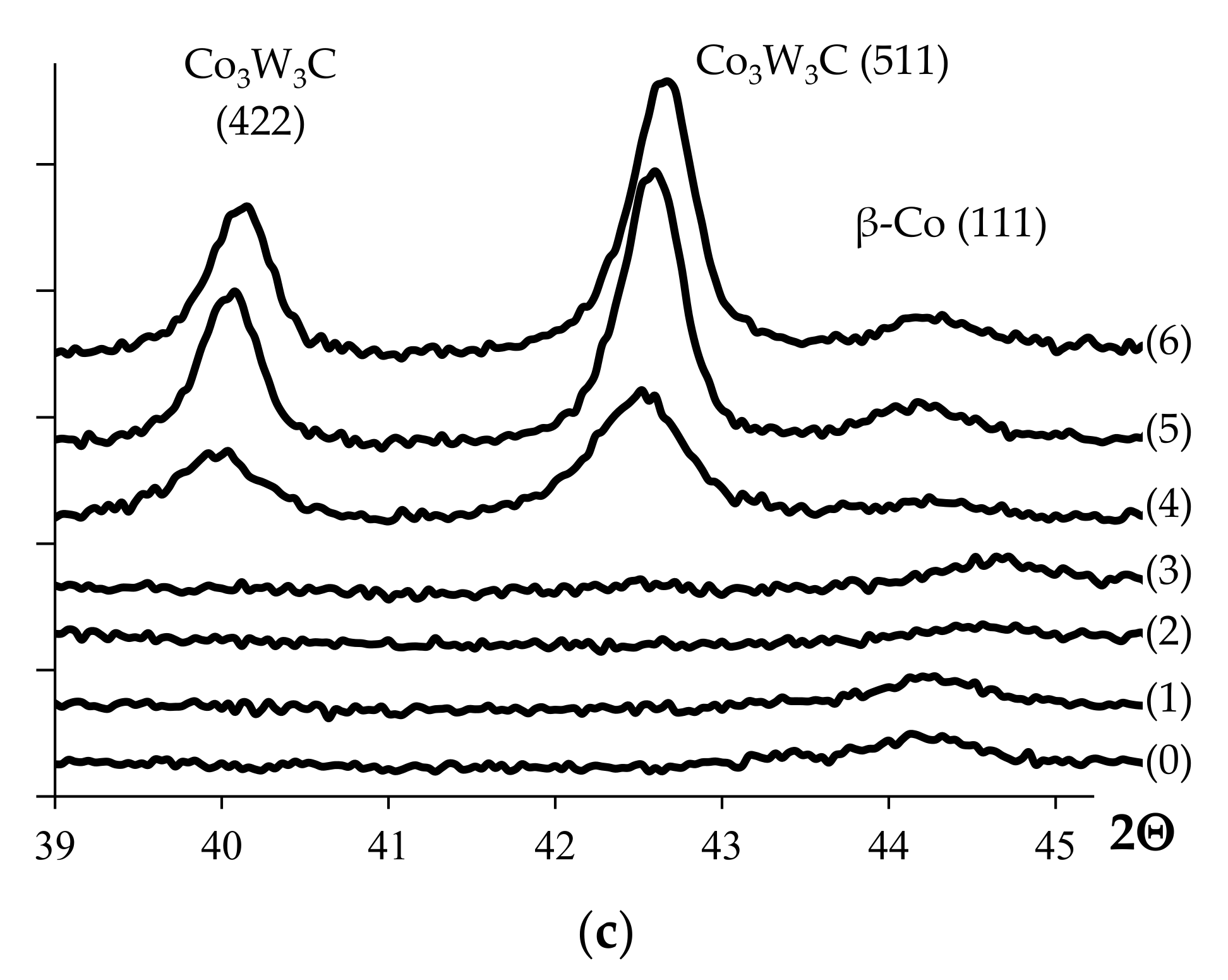
| Processing Stage | Depth from the Surface L, μm | Fraction of the η-Phase (Co3W3C), % Mass | ||
|---|---|---|---|---|
| Specimen #1 | Specimen #2 | Specimen #3 | ||
| 0 | 0 | 0 | 0 | 0 |
| 1 | 150 | 0 | 0 | 0 |
| 2 | 300 | 0 | 0 | 0 |
| 3 | 340 | “Traces” of η-phase detected | ||
| 4 | 380 | 12.7 ± 0.8 | 12.1 ± 0.7 | 15.2 ± 0.9 |
| 5 | 440 | 17.5 ± 0.9 | 13.7 ± 0.8 | 16.6 ± 0.9 |
| 6 | 500 | 17.7 ± 0.9 | 19.8 ± 0.9 | 18.2 ± 0.9 |
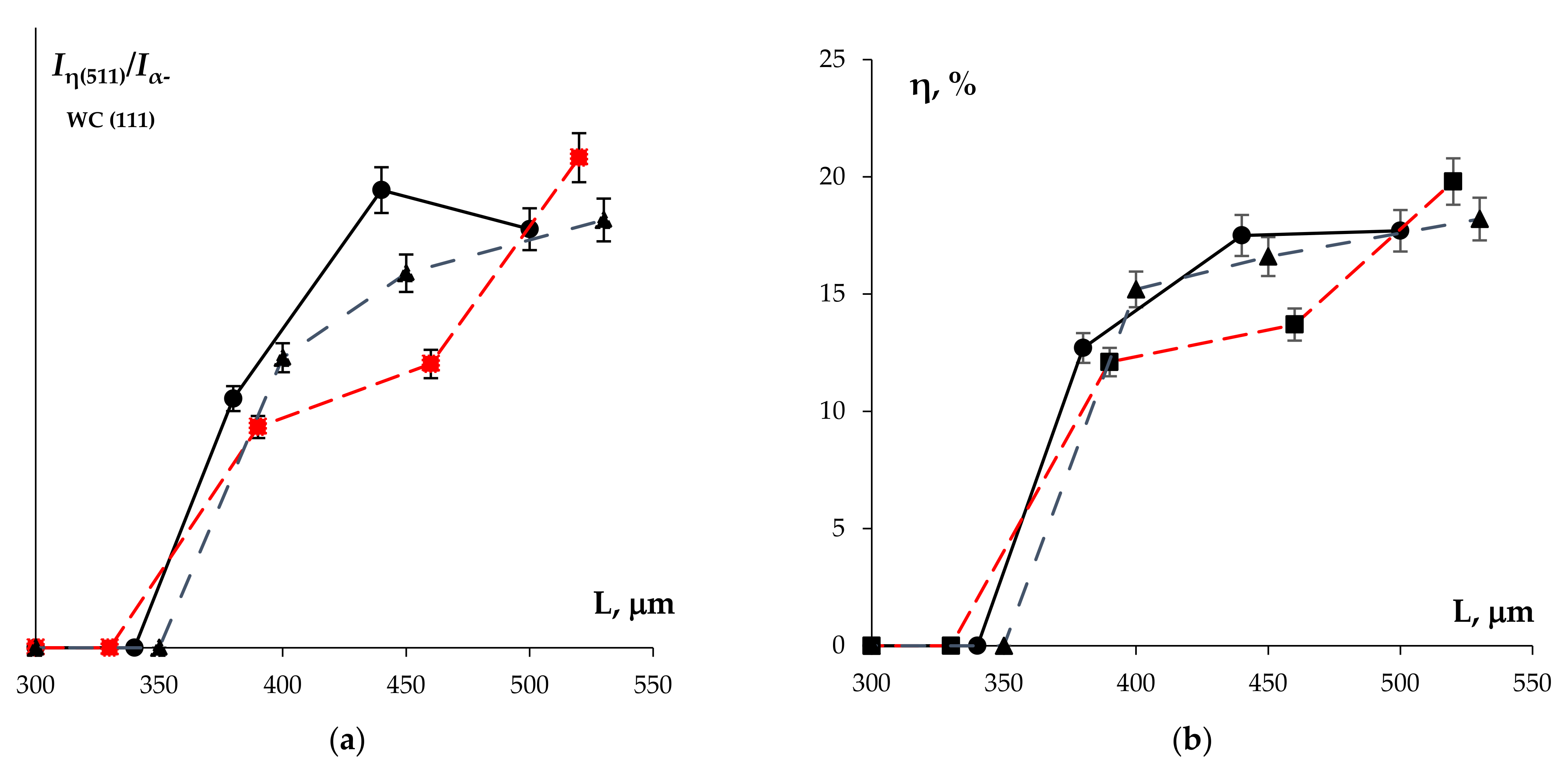
References
- Kurlov, A.S.; Gusev, A. Tungsten Carbides. Structure, Properties and Application in Hardmetals; Springer: Cham, Switzerland, 2013; p. 242. [Google Scholar]
- Loshak, M.G. Strength and Durability of Hard Alloys; Naukova Dumka: Kiev, Ukraine, 1984; p. 328. (In Russian) [Google Scholar]
- Panov, V.S.; Chuvilin, A.M. Technology and Properties of Sintered Hard Alloys and Their Products; MISIS: Moscow, Russia, 2001; p. 428. (In Russian) [Google Scholar]
- Upadhyaya, G.S. Cemented Tungsten Carbide. Production, Properties, and Testing; William Andrew Inc.: Norwich, NY, USA, 1998; p. 420. [Google Scholar]
- Fal’kovskiy, V.A.; Klyachko, L.I. Hard Alloys; Ore and Metals: Moscow, Russia, 2005; p. 413. (In Russian) [Google Scholar]
- García, J.; Ciprés, V.C.; Blomqvist, A.; Kaplan, B. Cemented carbide microstructures: A review. Int. J. Refract. Met. Hard Mater. 2019, 80, 40–68. [Google Scholar] [CrossRef]
- Leichtfried, G.; Sauthof, G.; Spriggs, G.E. Refractory, Hard and Inter.-Metallic Materials; Springer: Berlin/Heidelberg, Germany, 2002; p. 267. [Google Scholar]
- Kieffer, R.; Benesovsky, F. Hartmetalle; Springer: Vienna, Austria, 1965; p. 198. [Google Scholar]
- Konyashin, I.; Klyachko, L. History of cemented carbides in the Soviet Union. Int. J. Refract. Met. Hard Mater. 2015, 49, 9–26. [Google Scholar] [CrossRef]
- Panov, V.S. Nanostructured Sintered WC–Co Hard Metals (Review). Powder Met. Met. Ceram. 2015, 53, 643–654. [Google Scholar] [CrossRef]
- Konyashin, I.; Ries, B.; Hlawatschek, S.; Mazilkin, A. Novel industrial hardmetals for mining, construction and wear applications. Int. J. Refract. Met. Hard Mater. 2018, 71, 357–365. [Google Scholar] [CrossRef]
- Ortner, H.M.; Ettmayer, P.; Kolaska, H. The history of the technological progress of hardmetals. Int. J. Refract. Met. Hard Mater. 2014, 44, 148–159. [Google Scholar] [CrossRef]
- Jia, C.-C.; Tang, H.; Mei, X.-Z.; Yin, F.-Z.; Qu, X.-H. Spark plasma sintering on nanometer scale WC–Co powder. Mater. Lett. 2005, 59, 2566–2569. [Google Scholar] [CrossRef]
- Wang, X.; Xie, Y.; Guo, H.; Vanderbiest, O.; Vleugels, J. Sintering of WC-Co powder with nanocrystalline WC by spark plasma sintering. Rare Met. 2006, 25, 246–252. [Google Scholar] [CrossRef]
- Kim, H.-C.; Shon, I.-J.; Yoon, J.-K.; Doh, J.-M. Consolidation of ultra fine WC and WC–Co hard materials by pulsed current activated sintering and its mechanical properties. Int. J. Refract. Met. Hard Mater. 2007, 25, 46–52. [Google Scholar] [CrossRef]
- Xi, X.; Pi, X.; Nie, Z.; Song, S.; Xu, X.; Zuo, T. Synthesis and characterization of ultrafine WC–Co by freeze-drying and spark plasma sintering. Int. J. Refract. Met. Hard Mater. 2009, 27, 101–104. [Google Scholar] [CrossRef]
- Sun, L.; Jia, C.-C.; Lin, C.-G.; Cao, R.-J. VC Addition Prepared Ultrafine WC-11Co Composites by Spark Plasma Sintering. J. Iron Steel Res. Int. 2007, 14, 85–89. [Google Scholar] [CrossRef]
- Michalski, A.; Siemiaszko, D. Nanocrystalline cemented carbides sintered by the pulse plasma method. Int. J. Refract. Met. Hard Mater. 2007, 25, 153–158. [Google Scholar] [CrossRef]
- Cha, S.I.; Hong, S.H.; Kim, B.K. Spark plasma sintering behavior of nanocrystalline WC–10Co cemented carbide powders. Mater. Sci. Eng. A 2003, 351, 31–38. [Google Scholar] [CrossRef]
- Sun, L.; Lin, C.; Jia, C.; Jia, X.; Xian, M. Change in relative density of WC-Co cemented carbides in spark plasma sintering process. Rare Met. 2008, 27, 74–77. [Google Scholar] [CrossRef]
- Sivaprahasam, D.; Chandrasekar, S.; Sundaresan, R. Microstructure and mechanical properties of nanocrystalline WC–12Co consolidated by spark plasma sintering. Int. J. Refract. Met. Hard Mater. 2007, 25, 144–152. [Google Scholar] [CrossRef]
- Zhao, S.; Song, X.; Wang, M.; Liu, G.; Zhang, J. Preparation of ultrafine WC-Co cermets by combining pretreatment and consolidation with spark plasma sintering. Rare Met. 2009, 28, 391–395. [Google Scholar] [CrossRef]
- Sun, L.; Yang, T.; Jia, C.; Xiong, J. VC, Cr3C2 doped ultrafine WC–Co cemented carbides prepared by spark plasma sintering. Int. J. Refract. Met. Hard Mater. 2011, 29, 147–152. [Google Scholar] [CrossRef]
- Huang, S.; Li, L.; Vanmeensel, K.; Van der Biest, O.; Vleugels, J. VC, Cr3C2 and NbC doped WC–Co cemented carbides prepared by pulsed electric current sintering. Int. J. Refract. Met. Hard Mater. 2007, 25, 417–422. [Google Scholar] [CrossRef]
- Zhao, S.; Song, X.; Zhang, J.; Liu, X. Effects of scale combination and contact condition of raw powders on SPS sintered near-nanocrystalline WC–Co alloy. Mater. Sci. Eng. A 2008, 473, 323–329. [Google Scholar] [CrossRef]
- Huang, S.; Vanmeensel, K.; Li, L.; Van Der Biest, O.; Vleugels, J. Tailored sintering of VC-doped WC–Co cemented carbides by pulsed electric current sintering. Int. J. Refract. Met. Hard Mater. 2008, 26, 256–262. [Google Scholar] [CrossRef]
- Liu, X.; Song, X.; Zhang, J.; Zhao, S. Temperature distribution and neck formation of WC–Co combined particles during spark plasma sintering. Mater. Sci. Eng. A 2008, 488, 1–7. [Google Scholar] [CrossRef]
- Bonache, V.; Salvador, M.D.; Amigó, V.; Busquets, D.; Castro, A. Spark Plasma Sintering of Nanocrystalline WC-12Co Cermets. Ceram. Transact. 2010, 209, 367–378. [Google Scholar] [CrossRef]
- Bonache, V.; Salvador, M.; Fernández, A.; Borrell, A. Fabrication of full density near-nanostructured cemented carbides by combination of VC/Cr3C2 addition and consolidation by SPS and HIP technologies. Int. J. Refract. Met. Hard Mater. 2011, 29, 202–208. [Google Scholar] [CrossRef]
- Bonache, V.; Salvador, M.; Rocha, V.; Borrell, A. Microstructural control of ultrafine and nanocrystalline WC–12Co–VC/Cr3C2 mixture by spark plasma sintering. Ceram. Int. 2011, 37, 1139–1142. [Google Scholar] [CrossRef]
- Qin, Y.-Q.; Peng, Y.-Q.; Tian, Y.; Luo, L.-M.; Ma, Y.; Zan, X.; Zhu, X.-Y.; Wu, Y.-C. Effect of Y2O3 on microstructure and mechanical properties of WC-Co-cemented carbides prepared via solid-liquid doping method and spark plasma sintering. Mater. Today Commun. 2020, 24, 101096. [Google Scholar] [CrossRef]
- Wei, C.; Song, X.; Fu, J.; Liu, X.; Gao, Y.; Wang, H.; Zhao, S. Microstructure and properties of ultrafine cemented carbides—Differences in spark plasma sintering and sinter-HIP. Mater. Sci. Eng. A 2012, 552, 427–433. [Google Scholar] [CrossRef]
- Liu, X.; Song, X.; Wei, C.; Gao, Y.; Wang, H. Quantitative characterization of the microstructure and properties of nanocrystalline WC–Co bulk. Scr. Mater. 2012, 66, 825–828. [Google Scholar] [CrossRef]
- Buravlev, I.; Shichalin, O.; Papynov, E.; Golub, A.; Gridasova, E.; Buravleva, A.; Yagofarov, V.; Dvornik, M.; Fedorets, A.; Reva, V.; et al. WC-5TiC-10Co hard metal alloy fabrication via mechanochemical and SPS techniques. Int. J. Refract. Met. Hard Mater. 2021, 94, 105385. [Google Scholar] [CrossRef]
- Wang, B.; Jia, J.; Wang, Z.; Yin, Z.; Huang, L.; Yuan, J. Fabrication and performance of graded ultrafine WC–Co cemented carbide tool by one/two-step spark plasma sintering. Ceram. Int. 2021, 47, 8322–8329. [Google Scholar] [CrossRef]
- Wang, B.; Wang, Z.; Yuan, J.; Yin, Z.; Huang, L.; Zheng, K. High temperature fracture mechanism of ultrafine WC-Co cemented carbides containing (Ti,W)C. Int. J. Refract. Met. Hard Mater. 2021, 95, 105428. [Google Scholar] [CrossRef]
- Dembiczak, T.; Balaga, Z.; Opydo, M.; Kruzel, R.; Garbiec, D.; Dyner, M. The effect of the binder phase and sintering temperature on the properties of Spark Plasma Sintering WC-Co cemented carbides. Manuf. Technol. 2021, 21, 45–50. [Google Scholar] [CrossRef]
- Wang, Z.; Yu, B.; Liu, K.; Yin, Z.; Yuan, J.; Zhu, Y. Performance and wear mechanism of spark plasma sintered WC-Based ultrafine cemented carbides tools in dry turning of Ti–6Al–4V. Ceram. Int. 2020, 46, 20207–20214. [Google Scholar] [CrossRef]
- Liu, K.; Wang, Z.; Yin, Z.; Cao, L.; Yuan, J. Effect of Co content on microstructure and mechanical properties of ultrafine grained WC-Co cemented carbide sintered by spark plasma sintering. Ceram. Int. 2018, 44, 18711–18718. [Google Scholar] [CrossRef]
- Wang, Z.; Wang, B.; Yin, Z.; Liu, K. Tribological behavior of spark plasma sintered ultrafine-grained WC-cobalt cemented carbides in dry sliding. Proc. Inst. Mech. Eng. Part C J. Mech. Eng. Sci. 2020, 234, 2707–2715. [Google Scholar] [CrossRef]
- Wang, B.; Wang, Z.; Yin, Z.; Yuan, J.; Jia, J. Preparation and properties of the VC/Cr3C2/TaC doped ultrafine WC-Co tool material by spark plasma sintering. J. Alloy. Compd. 2020, 816, 152598. [Google Scholar] [CrossRef]
- Su, W.; Zou, J.; Sun, L. Effects of nano-alumina on mechanical properties and wear resistance of WC-8Co cemented carbide by spark plasma sintering. Int. J. Refract. Met. Hard Mater. 2020, 92, 105337. [Google Scholar] [CrossRef]
- Yang, Y.; Luo, L.-M.; Zan, X.; Zhu, X.-Y.; Zhu, L.; Wu, Y.-C. Synthesis of Y2O3-doped WC-Co powders by wet chemical method and its effect on the properties of WC-Co cemented carbide alloy. Int. J. Refract. Met. Hard Mater. 2020, 92, 105324. [Google Scholar] [CrossRef]
- Peng, Y.; Wang, H.; Zhao, C.; Hu, H.; Liu, X.; Song, X. Nanocrystalline WC-Co composite with ultrahigh hardness and toughness. Compos. Part. B Eng. 2020, 197, 108161. [Google Scholar] [CrossRef]
- Al Wohaibi, S.; Mohammed, A.S.; Laoui, T.; Hakeem, A.S.; Adesina, A.Y.; Patel, F. Tribological Characterization of Micron-/Nano-Sized WC-9%Co Cemented Carbides Prepared by Spark Plasma Sintering at Elevated Temperatures. Materials 2019, 12, 920. [Google Scholar] [CrossRef]
- Wang, Z.; Liu, Y.; Liu, K.; Wang, B. Mechanical properties and microstructure of spark plasma sintered WC-8 wt.%Co-VC-cBN ultrafine grained cemented carbide. Ceram. Int. 2019, 45, 23658–23665. [Google Scholar] [CrossRef]
- Wang, B.; Wang, Z.; Yin, Z.; Liu, K.; Yuan, J. Effects of powder preparation and sintering temperature on consolidation of ultrafine WC-8Co tool material produced by spark plasma sintering. Ceram. Int. 2019, 45, 19737–19746. [Google Scholar] [CrossRef]
- Langa, T.; Olubambi, P.; Shabalala, T.; Shongwe, M.B. Densification and structural transformation during spark plasma sintering of WC-Co-YSZ-cBN systems. Int. J. Refract. Met. Hard Mater. 2018, 72, 341–348. [Google Scholar] [CrossRef]
- Yuan, X.; Song, X.; Chien, H.; Li, J.; Rohrer, G.S. Effect of densification mechanism on the Σ2 grain boundary plane distribution in WC–Co composites. Mater. Lett. 2013, 92, 86–89. [Google Scholar] [CrossRef]
- Sun, X.; Wang, Y.; Li, D. Mechanical properties and erosion resistance of ceria nano-particle-doped ultrafine WC–12Co composite prepared by spark plasma sintering. Wear 2013, 301, 406–414. [Google Scholar] [CrossRef]
- Espinosa-Fernández, L.; Borrell, A.; Salvador, M.; Gutierrez-Gonzalez, C. Sliding wear behavior of WC–Co–Cr3C2–VC composites fabricated by conventional and non-conventional techniques. Wear 2013, 307, 60–67. [Google Scholar] [CrossRef]
- Liu, X.M.; Song, X.Y.; Bin Wang, H.; Gao, Y.; Wang, Y. Effect of VC Addition on Microstructure and Mechanical Properties of Ultrafine Grained WC-Co Alloys. Adv. Mater. Res. 2014, 893, 444–448. [Google Scholar] [CrossRef]
- Mandel, K.; Krüger, L.; Schimpf, C. Study on parameter optimisation for field-assisted sintering of fully-dense, near-nano WC–12Co. Int. J. Refract. Met. Hard Mater. 2014, 45, 153–159. [Google Scholar] [CrossRef]
- Mandel, K.; Krüger, L.; Krause, R.; Radajewski, M. The influence of stress state on the compressive strength of WC–Co with different Co contents. Int. J. Refract. Met. Hard Mater. 2014, 47, 124–130. [Google Scholar] [CrossRef]
- Al-Aqeeli, N.; Mohammad, K.; Laoui, T.; Saheb, N. The Effect of Variable Binder Content and Sintering Temperature on the Mechanical Properties of WC–Co–VC/Cr3C2 Nanocomposites. Mater. Manuf. Process. 2014, 30, 327–334. [Google Scholar] [CrossRef]
- Lee, S.; Hong, H.S.; Kim, H.-S.; Hong, S.-J.; Yoon, J.-H. Spark plasma sintering of WC–Co tool materials prepared with emphasis on WC core–Co shell structure development. Int. J. Refract. Met. Hard Mater. 2015, 53, 41–45. [Google Scholar] [CrossRef]
- Wang, X.; Wang, H.; Moscatelli, R.; Liu, X.; Song, X. Cemented carbides with highly oriented WC grains and formation mechanisms. Mater. Sci. Eng. A 2016, 659, 76–83. [Google Scholar] [CrossRef]
- Ogunmuyiwa, E.N.; Sacks, N.; Bergström, L.; Akhtar, F. Effect of 10 wt% VC on the Friction and Sliding Wear of Spark Plasma–Sintered WC–12 wt% Co Cemented Carbides. Tribol. Trans. 2017, 60, 276–283. [Google Scholar] [CrossRef]
- Kurlov, A.; Gusev, A. Peculiarities of vacuum annealing of nanocrystalline WC powders. Int. J. Refract. Met. Hard Mater. 2012, 32, 51–60. [Google Scholar] [CrossRef]
- Kurlov, A.S. Effects of vacuum annealing on the particle size and phase composition of nanocrystalline tungsten carbide powders. Russ. J. Phys. Chem. A 2013, 87, 654–661. [Google Scholar] [CrossRef]
- Konyashin, I.; Zaitsev, A.; Sidorenko, D.; Levashov, E.; Ries, B.; Konischev, S.; Sorokin, M.; Mazilkin, A.; Herrmann, M.; Kaiser, A. Wettability of tungsten carbide by liquid binders in WC–Co cemented carbides: Is it complete for all carbon contents? Int. J. Refract. Met. Hard Mater. 2017, 62, 134–148. [Google Scholar] [CrossRef]
- Wang, H.; Song, X.; Liu, X.; Gao, Y.; Wei, C.; Wang, Y.; Guo, G. Effect of carbon content of WC–Co composite powder on properties of cermet coating. Powder Technol. 2013, 246, 492–498. [Google Scholar] [CrossRef]
- Sugiyama, I.; Mizumukai, Y.; Taniuchi, T.; Okada, K.; Shirase, F.; Tanase, T.; Ikuhara, Y.; Yamamoto, T. Carbon content dependence of grain growth mode in VC-doped WC–Co hardmetals. Int. J. Refract. Met. Hard Mater. 2015, 52, 245–251. [Google Scholar] [CrossRef]
- Konyashin, I.; Hlawatschek, S.; Ries, B.; Lachmann, F.; Dorn, F.; Sologubenko, A.; Weirich, T. On the mechanism of WC coarsening in WC–Co hardmetals with various carbon contents. Int. J. Refract. Met. Hard Mater. 2009, 27, 234–243. [Google Scholar] [CrossRef]
- Chabretou, V.; Allibert, C.H.; Missiaen, J.M. Quantitative analysis of the effect of the binder phase composition on grain growth in WC-Co sintered materials. J. Mater. Sci. 2003, 38, 2581–2590. [Google Scholar] [CrossRef]
- Wang, Y.; Heusch, M.; Lay, S.; Allibert, C. Microstructure Evolution in the Cemented Carbides WC-Co, I. Effect of the C/W Ratio on the Morphology and Defects of the WC Grains. Phys. Status Solidi 2002, 193, 271–283. [Google Scholar] [CrossRef]
- Gu, L.; Huang, J.; Xie, C. Effects of carbon content on microstructure and properties of WC–20Co cemented carbides. Int. J. Refract. Met. Hard Mater. 2014, 42, 228–232. [Google Scholar] [CrossRef]
- Kim, S.; Han, S.-H.; Park, J.-K.; Kim, H.-E. Variation of WC grain shape with carbon content in the WC–Co alloys during liquid-phase sintering. Scr. Mater. 2003, 48, 635–639. [Google Scholar] [CrossRef]
- Nino, A.; Takahashi, K.; Sugiyama, S.; Taimatsu, H. Effects of Carbon Addition on Microstructures and Mechanical Properties of Binderless Tungsten Carbide. Mater. Trans. 2012, 53, 1475–1480. [Google Scholar] [CrossRef]
- Wei, C.; Song, X.; Fu, J.; Lv, X.; Wang, H.; Gao, Y.; Zhao, S.; Liu, X. Effect of Carbon Addition on Microstructure and Properties of WC–Co Cemented Carbides. J. Mater. Sci. Technol. 2012, 28, 837–843. [Google Scholar] [CrossRef]
- Bounhoure, V.; Lay, S.; Charlot, F.; Antoni-Zdziobek, A.; Pauty, E.; Missiaen, J. Effect of C content on the microstructure evolution during early solid state sintering of WC–Co alloys. Int. J. Refract. Met. Hard Mater. 2014, 44, 27–34. [Google Scholar] [CrossRef]
- Petersson, A. Sintering shrinkage of WC–Co and WC–(Ti,W)C–Co materials with different carbon contents. Int. J. Refract. Met. Hard Mater. 2004, 22, 211–217. [Google Scholar] [CrossRef]
- Krasovskii, P.V.; Blagoveshchenskii, Y.V.; Grigorovich, K.V. Determination of oxygen in W-C-Co nanopowders. Inorg. Mater. 2008, 44, 954–959. [Google Scholar] [CrossRef]
- Fang, Z.Z.; Wang, X.; Ryu, T.; Hwang, K.S.; Sohn, H. Synthesis, sintering, and mechanical properties of nanocrystalline cemented tungsten carbide—A review. Int. J. Refract. Met. Hard Mater. 2009, 27, 288–299. [Google Scholar] [CrossRef]
- Tokita, M. Spark Plasma Sintering (SPS) Method, Systems, and Applications. Chapter 11.2.3. In Handbook of Advanced Ceramics, 2nd ed.; Academic Press: Cambridge, MA, USA, 2013; Volume 11, pp. 1149–1177. [Google Scholar] [CrossRef]
- Olevsky, E.A.; Dudina, D.V. Field-Assisted Sintering; Springer: Cham, Switzerland, 2018; p. 425. [Google Scholar]
- Tokita, M. Progress of Spark Plasma Sintering (SPS) Method, Systems, Ceramics Applications and Industrialization. Ceramics 2021, 4, 160–198. [Google Scholar] [CrossRef]
- Dudina, D.; Ukhina, A.; Bokhonov, B.; Mali, V.; Anisimov, A.; Bulina, N.; Skovorodin, I. Nickel-graphite composites of variable architecture by graphitization-accompanied spark plasma sintering and hot pressing and their response to phase separation. Sci. Sinter. 2015, 47, 237–248. [Google Scholar] [CrossRef]
- Dudina, D.V.; Bokhonov, B.B.; Ukhina, A.V.; Anisimov, A.G.; Mali, V.; Esikov, M.A.; Batraev, I.; Kuznechik, O.O.; Pilinevich, L.P. Reactivity of materials towards carbon of graphite foil during Spark Plasma Sintering: A case study using Ni–W powders. Mater. Lett. 2016, 168, 62–67. [Google Scholar] [CrossRef]
- Samokhin, A.V.; Alekseev, N.V.; Kornev, S.A.; Sinaiskii, M.A.; Blagoveschenskiy, Y.V.; Kolesnikov, A.V. Tungsten Carbide and Vanadium Carbide Nanopowders Synthesis in DC Plasma Reactor. Plasma Chem. Plasma Process. 2013, 33, 605–616. [Google Scholar] [CrossRef]
- Blagoveshchenskiy, Y.V.; Isayeva, N.V.; Blagoveshchenskaya, N.V.; Melnik, Y.I.; Chuvildeyev, V.N.; Nokhrin, A.V.; Sakharov, N.V.; Boldin, M.S.; Smirnov, Y.S.; Shotin, S.V.; et al. Methods of compacting nanostructured tungsten–cobalt alloys from Nanopowders obtained by plasma chemical synthesis. Inorg. Mater. Appl. Res. 2015, 6, 415–426. [Google Scholar] [CrossRef]
- Isaeva, N.V.; Blagoveshchenskii, Y.V.; Blagoveshchenskaya, N.V.; Mel’nik, Y.I.; Samokhin, A.V.; Alekseev, N.V.; Astashov, A. Preparation of nanopowders of carbides and hard-alloy mixtures applying low-temperature plasma. Russ. J. Non-Ferrous Met. 2014, 55, 585–591. [Google Scholar] [CrossRef]
- Blagoveshchenskiy, Y.V.; Isaeva, N.V.; Sinaiskiy, M.A.; Ankudinov, A.B.; Zelensky, V.A. Tuning the Properties of Refractory Carbide Nanopowders. Inorg. Mater. Appl. Res. 2018, 9, 924–929. [Google Scholar] [CrossRef]
- Chuvil’deev, V.; Blagoveshchenskiy, Y.; Nokhrin, A.; Boldin, M.; Sakharov, N.; Isaeva, N.; Shotin, S.; Belkin, O.; Popov, A.; Smirnova, E.; et al. Spark plasma sintering of tungsten carbide nanopowders obtained through DC arc plasma synthesis. J. Alloy. Compd. 2017, 708, 547–561. [Google Scholar] [CrossRef]
- Chuvil’deev, V.N.; Moskvicheva, A.V.; Lopatin, Y.G.; Blagoveshchenskii, Y.V.; Isaeva, N.V.; Mel’Nik, Y.I. Sintering of WC and WC-Co nanopowders with different inhibitor additions by the SPS method. Dokl. Phys. 2011, 56, 114–117. [Google Scholar] [CrossRef]
- Lantsev, E.; Malekhonova, N.; Nokhrin, A.; Chuvil’deev, V.; Boldin, M.; Andreev, P.; Smetanina, K.; Blagoveshchenskiy, Y.; Isaeva, N.; Murashov, A. Spark plasma sintering of fine-grained WC hard alloys with ultra-low cobalt content. J. Alloy. Compd. 2021, 857, 157535. [Google Scholar] [CrossRef]
- Lantsev, E.; Malekhonova, N.; Nokhrin, A.; Chuvil’deev, V.; Boldin, M.; Blagoveshchenskiy, Y.; Andreev, P.; Smetanina, K.; Isaeva, N.; Shotin, S. Influence of oxygen on densification kinetics of WC nanopowders during SPS. Ceram. Int. 2021, 47, 4294–4309. [Google Scholar] [CrossRef]
- Krasovskii, P.V.; Malinovskaya, O.S.; Samokhin, A.V.; Blagoveshchenskiy, Y.V.; Kazakov, V.A.; Ashmarin, A.A. XPS study of surface chemistry of tungsten carbides nanopowders produced through DC thermal plasma/hydrogen annealing process. Appl. Surf. Sci. 2015, 339, 46–54. [Google Scholar] [CrossRef]
- He, R.; Wang, J.; He, M.; Yang, H.; Ruan, J. Synthesis of WC composite powder with nano-cobalt coatings and its application in WC-4Co cemented carbide. Ceram. Int. 2018, 44, 10961–10967. [Google Scholar] [CrossRef]
- Blagoveshchensky, Y.V.; Alexeev, N.V.; Samokhin, A.V.; Isaeva, N.V.; Sinaysky, M.A.; Tsvetkov, Y.V. Effect of the Conditions of Formation of W–C Nanopowders in a Plasma Jet on the Synthesis of Hexagonal Tungsten Carbide. Inorg. Mater. Appl. Res. 2019, 10, 566–571. [Google Scholar] [CrossRef]
- Kurlov, A.; Gusev, A.; Rempel, A. Vacuum sintering of WC-8 wt.%Co hardmetals from WC powders with different dispersity. Int. J. Refract. Met. Hard Mater. 2011, 29, 221–231. [Google Scholar] [CrossRef]
- Roebuck, B. Extrapolating hardness-structure property maps in WC/Co hardmetals. Int. J. Refract. Met. Hard Mater. 2006, 24, 101–108. [Google Scholar] [CrossRef]
- Petersson, A.; Ågren, J. Sintering shrinkage of WC–Co materials with different compositions. Int. J. Refract. Met. Hard Mater. 2005, 23, 258–266. [Google Scholar] [CrossRef]
- Gille, G.; Szesny, B.; Leitner, G. A new 0.4 μm WC powder as well as powder-related properties and sintering behaviour of 0.6 to 30 μm WC-Co hardmetals. J. Adv. Mater. 1999, 31, 9–22. [Google Scholar]
- De Macedo, H.; Da Silva, A.; Melo, D. The spreading of cobalt, nickel and iron on tungsten carbide and the first stage of hard metal sintering. Mater. Lett. 2003, 57, 3924–3932. [Google Scholar] [CrossRef]
- Petersson, A. Cemented Carbide Sintering: Constitutive Relations and Microstructural Evolution. Ph.D. Thesis, Department of Materials Science and Engineering, Royal Institute of Technology, Stockholm, Sweden, 2004. [Google Scholar]
- Poirier, G.-P. Plasticité À Haute Température des Solidescristallins; Eyrolles: France, Paris, 1976; p. 301. [Google Scholar]
- Frost, H.J.; Ashby, M.F. Deformation-Mechanism Maps: The Plasticity and Creep of Metals and Ceramics; Pergamon Press: Oxford, UK, 1982; p. 165. [Google Scholar]
- Larikov, L.N.; Isaichev, V.I. Diffusion in Metals and Alloys; Naukova Dumka: Kiev, Ukraine, 1989; p. 512. (In Russian) [Google Scholar]
- Young, W.S.; Cutler, I.B. Initial Sintering with Constant Rates of Heating. J. Am. Ceram. Soc. 1970, 53, 659–663. [Google Scholar] [CrossRef]
- Kumar, A.N.; Watabe, M.; Kurokawa, K. The sintering kinetics of ultrafine tungsten carbide powders. Ceram. Int. 2011, 37, 2643–2654. [Google Scholar] [CrossRef]
- Johnson, D.L. New Method of Obtaining Volume, Grain-Boundary, and Surface Diffusion Coefficients from Sintering Data. J. Appl. Phys. 1969, 40, 192–200. [Google Scholar] [CrossRef]
- Lavergne, O.; Robaut, F.; Hodaj, F.; Allibert, C. Mechanism of solid-state dissolution of WC in Co-based solutions. Acta Mater. 2002, 50, 1683–1692. [Google Scholar] [CrossRef]
- Gille, G.; Szesny, B.; Dreyer, K.; Berg, H.V.D.; Schmidt, J.; Gestrich, T.; Leitner, G. Submicron and ultrafine grained hardmetals for microdrills and metal cutting inserts. Int. J. Refract. Met. Hard Mater. 2002, 20, 3–22. [Google Scholar] [CrossRef]
- Chuvil’deev, V.N.; Boldin, M.S.; Dyatlova, Y.G.; Rumyantsev, V.I.; Ordanyan, S.S. A comparative study of the hot pressing and spark plasma sintering of Al2O3–ZrO2–Ti(C,N) powders. Inorg. Mater. 2015, 51, 1047–1053. [Google Scholar] [CrossRef]
- Golovkina, L.; Orlova, A.; Nokhrin, A.; Boldin, M.; Chuvil’deev, V.; Sakharov, N.; Belkin, O.; Shotin, S.; Zelenov, A. Spark Plasma Sintering of fine-grain ceramic-metal composites based on garnet-structure oxide Y2.5Nd0.5Al5O12 for inert matrix fuel. Mater. Chem. Phys. 2018, 214, 516–526. [Google Scholar] [CrossRef]
- Meredith, B.; Milner, D.R. Densification Mechanisms in the Tungsten Carbide—Cobalt System. Powder Met. 1976, 19, 38–45. [Google Scholar] [CrossRef]
- Huang, S.; Vanmeensel, K.; Li, L.; Van Der Biest, O.; Vleugels, J. Influence of starting powder on the microstructure of WC–Co hardmetals obtained by spark plasma sintering. Mater. Sci. Eng. A 2008, 475, 87–91. [Google Scholar] [CrossRef]
- Buhsmer, C.P.; Crayton, P.H. Carbon self-diffusion in tungsten carbide. J. Mater. Sci. 1971, 6, 981–988. [Google Scholar] [CrossRef]
- Pelleg, J. Diffusion in Ceramics; Springer: Cham, Switzerland, 2016; p. 448. [Google Scholar]
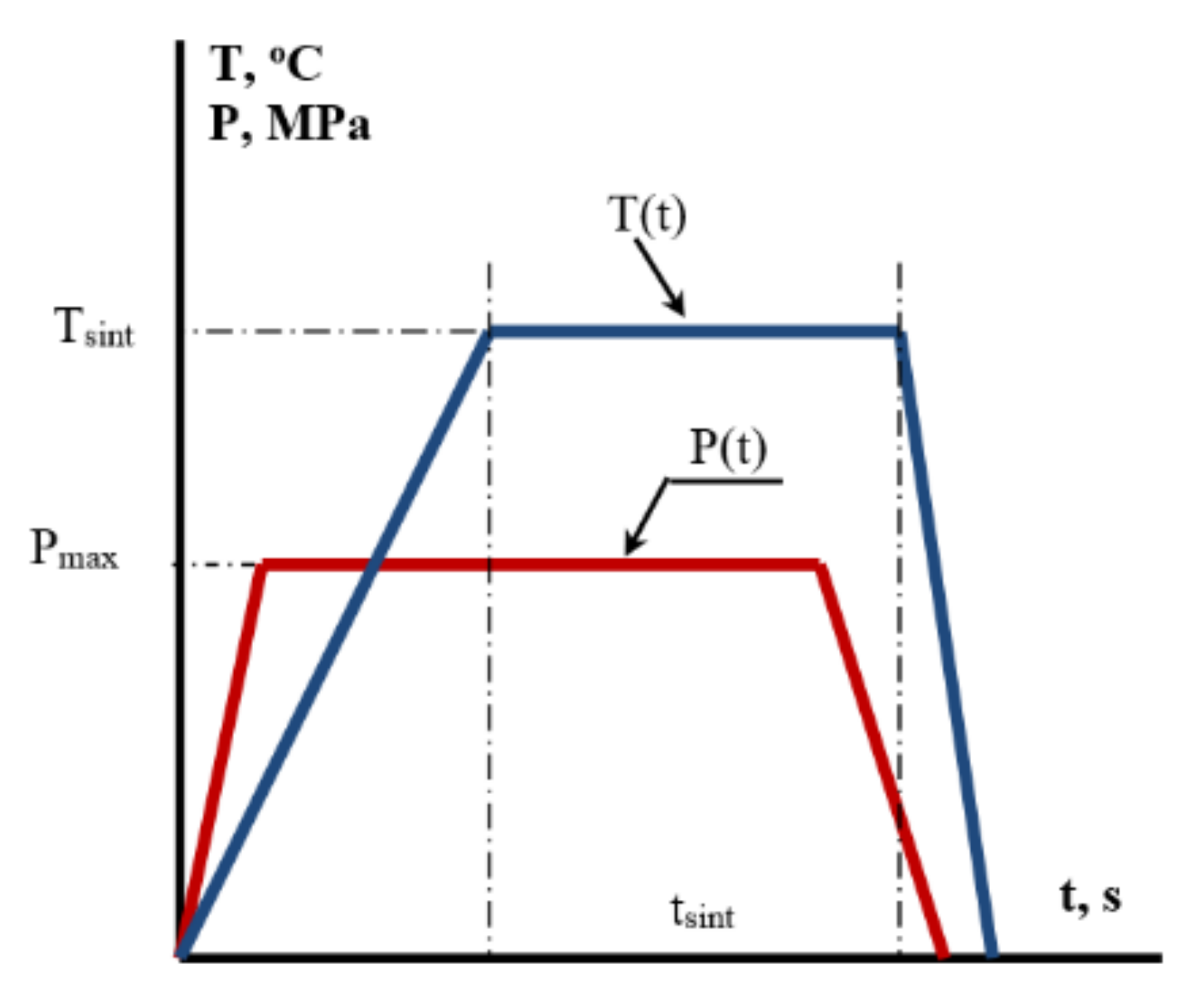

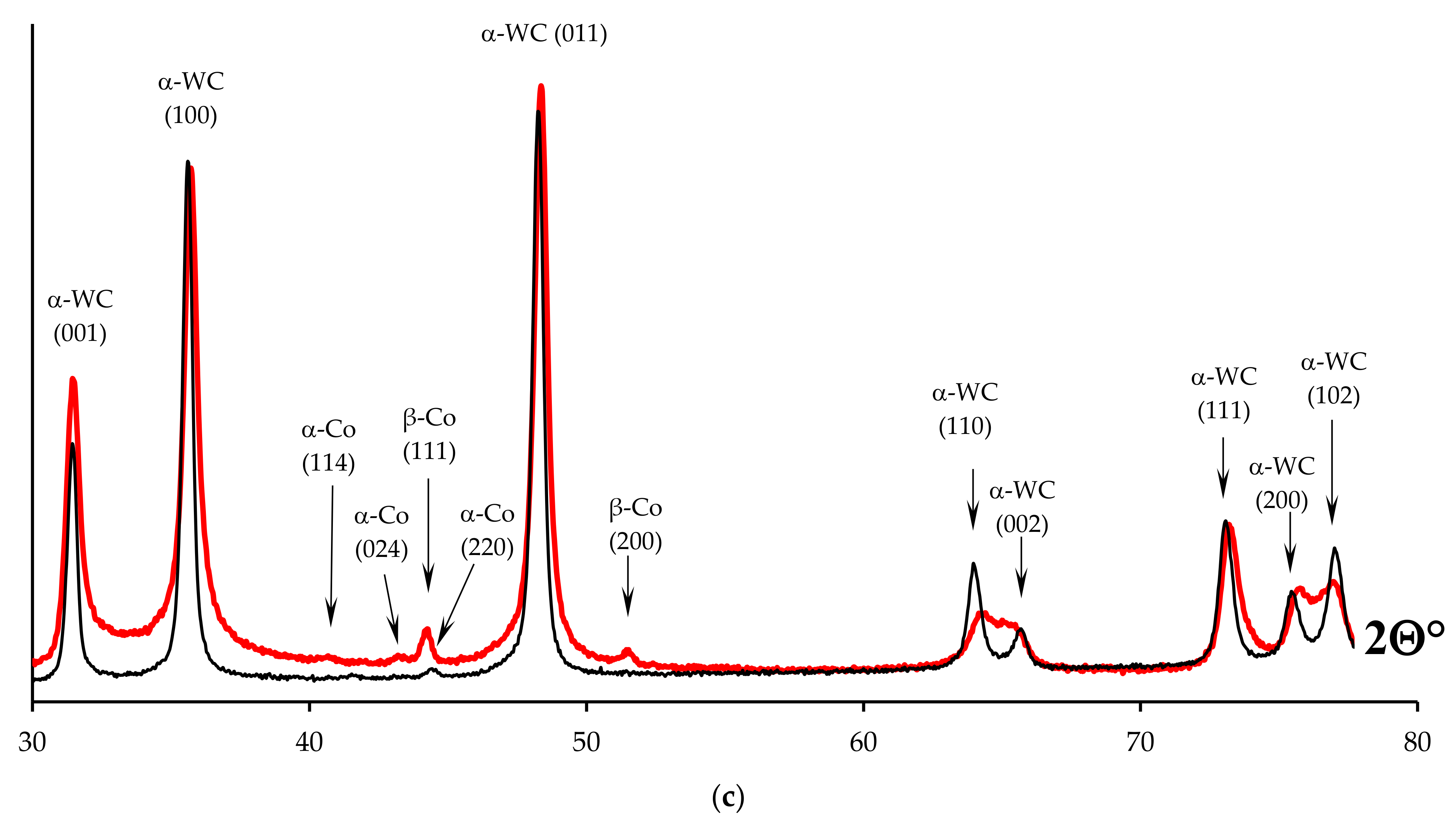
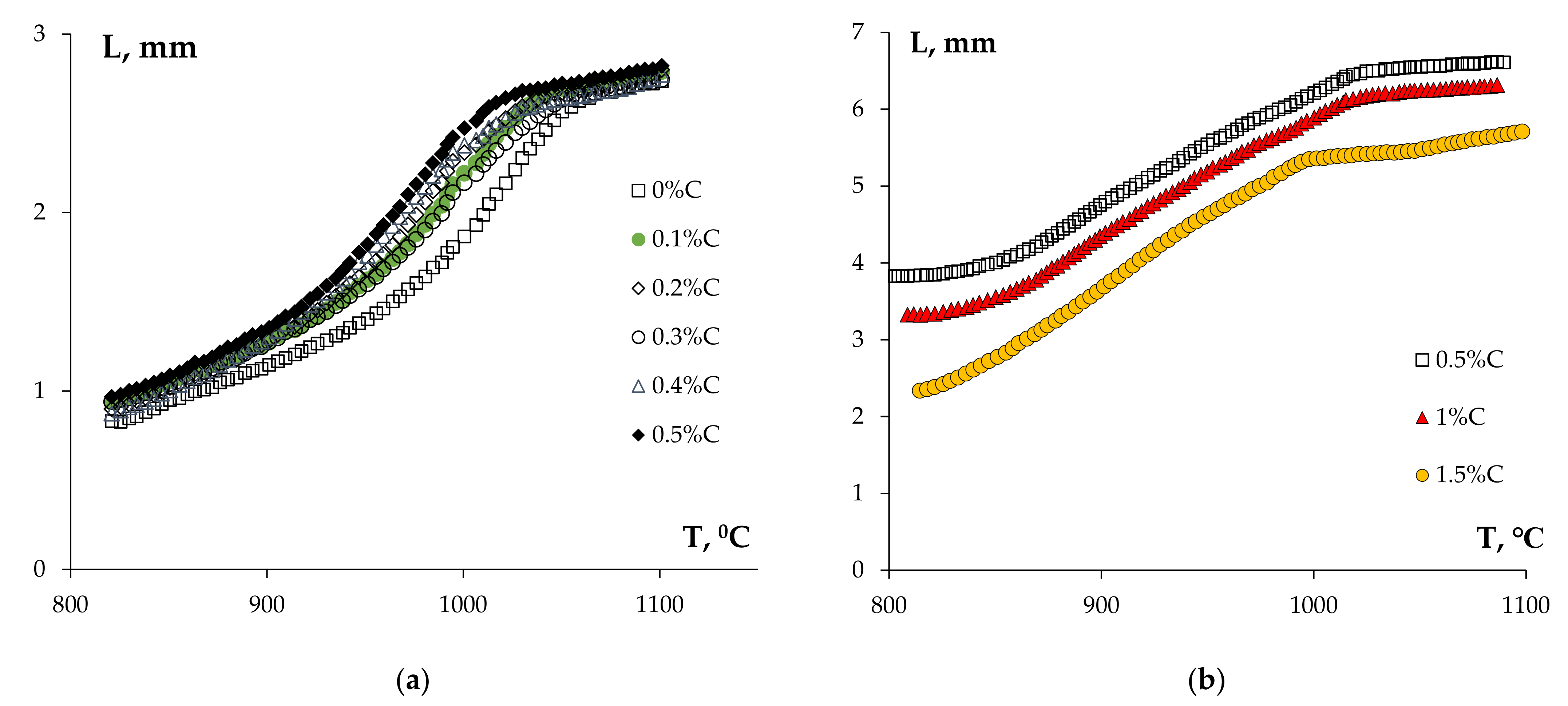


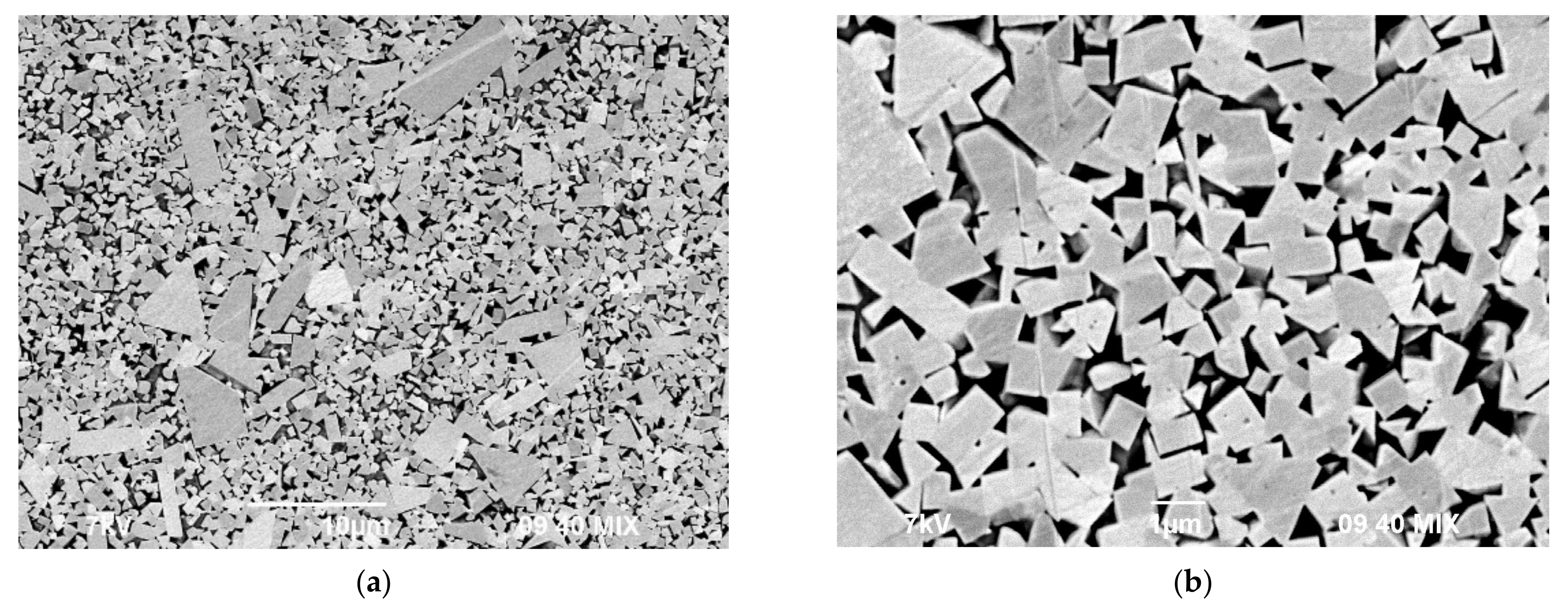
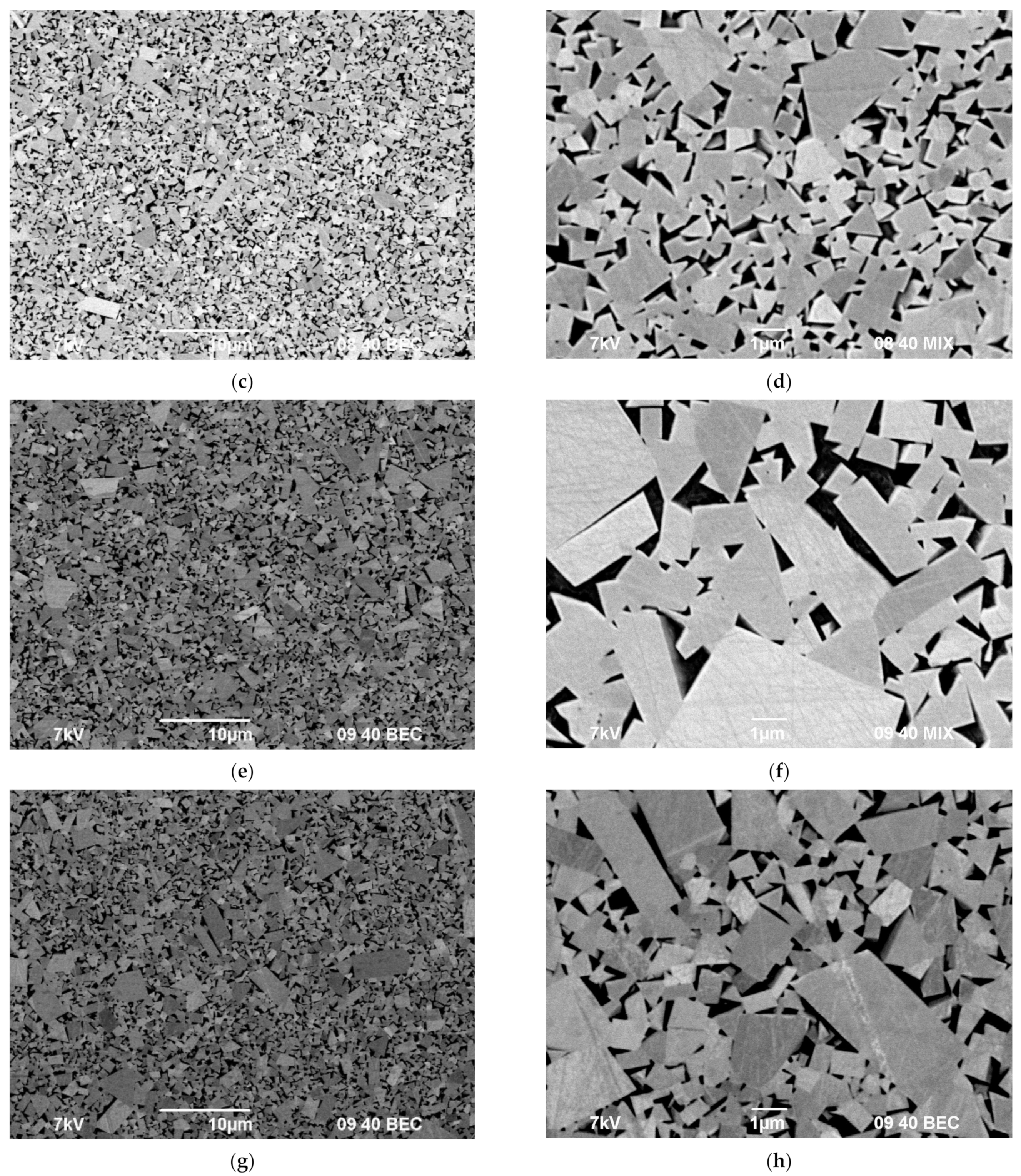
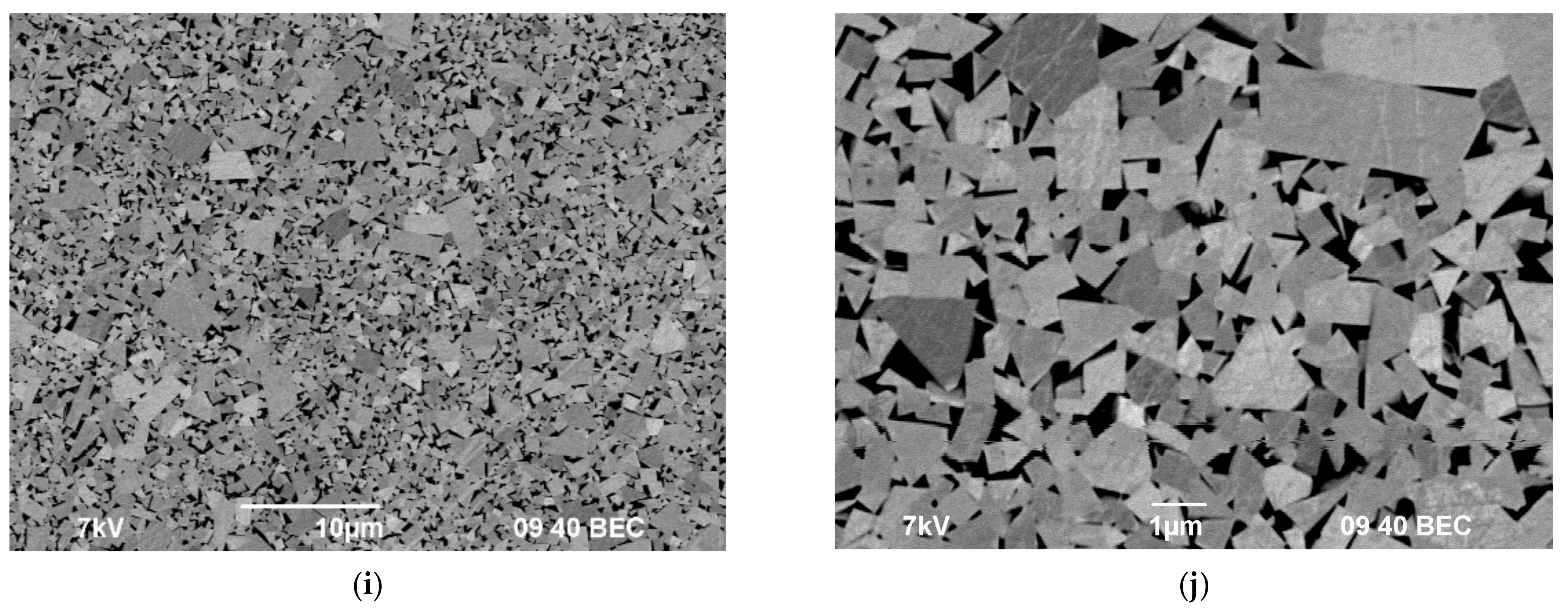


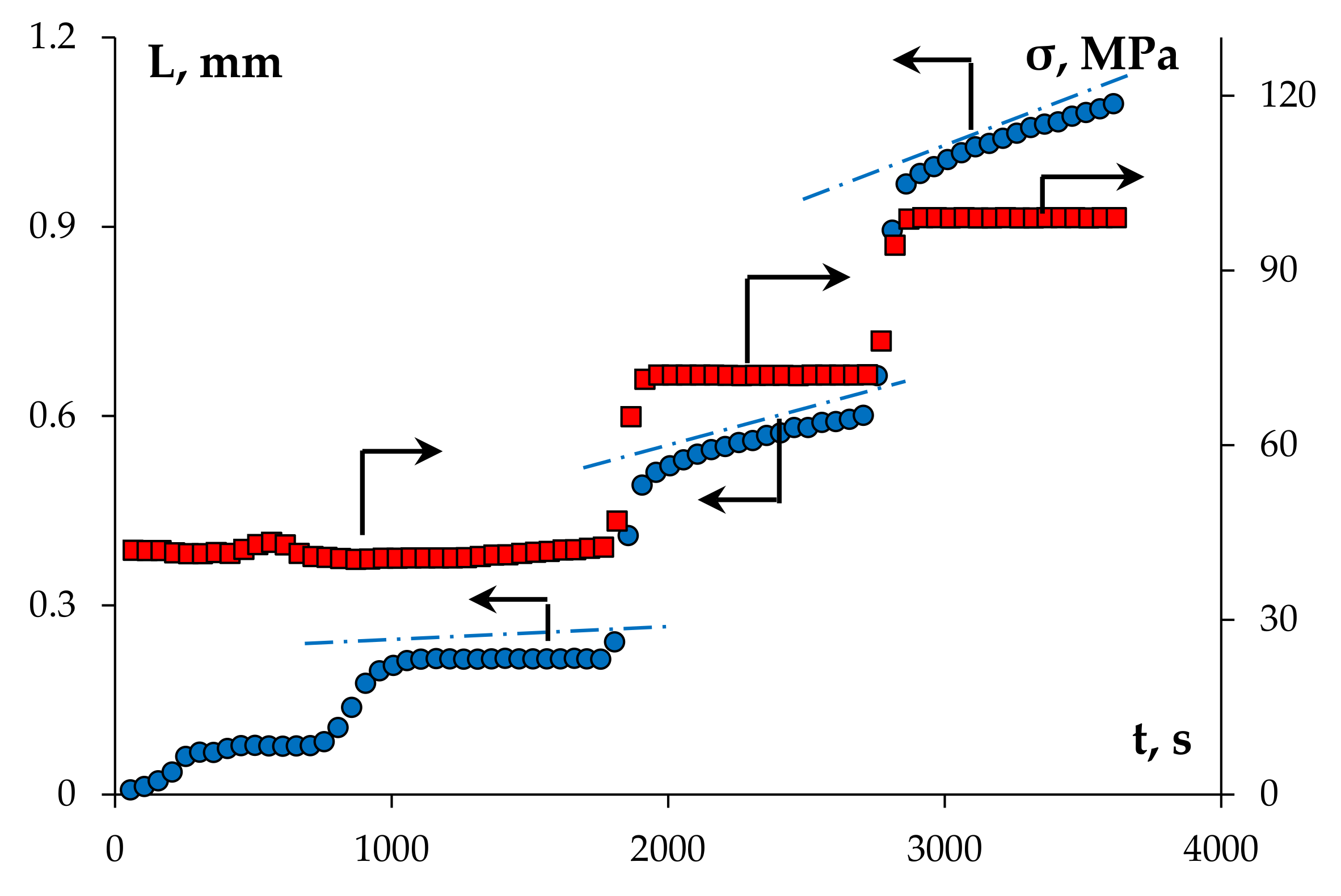
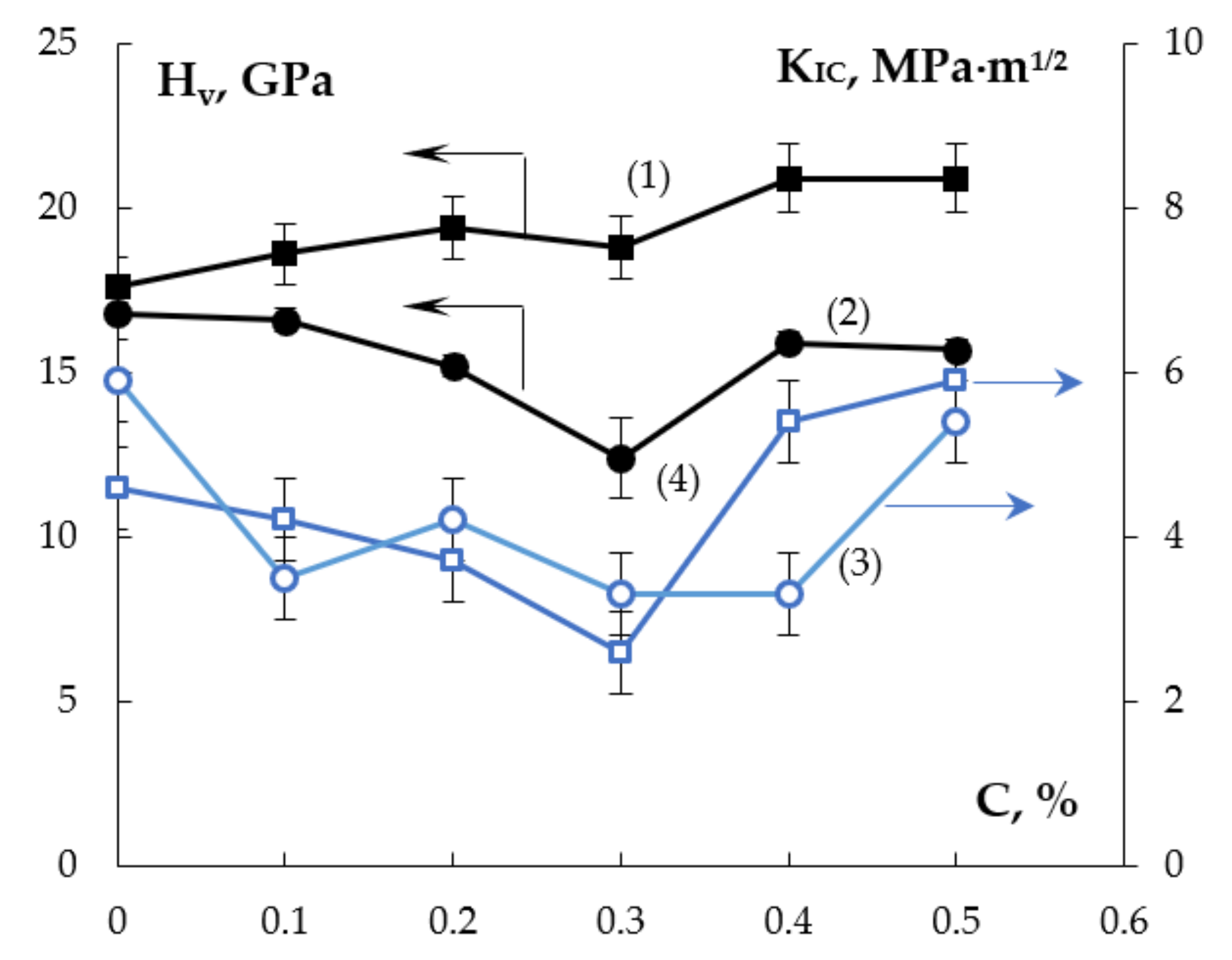

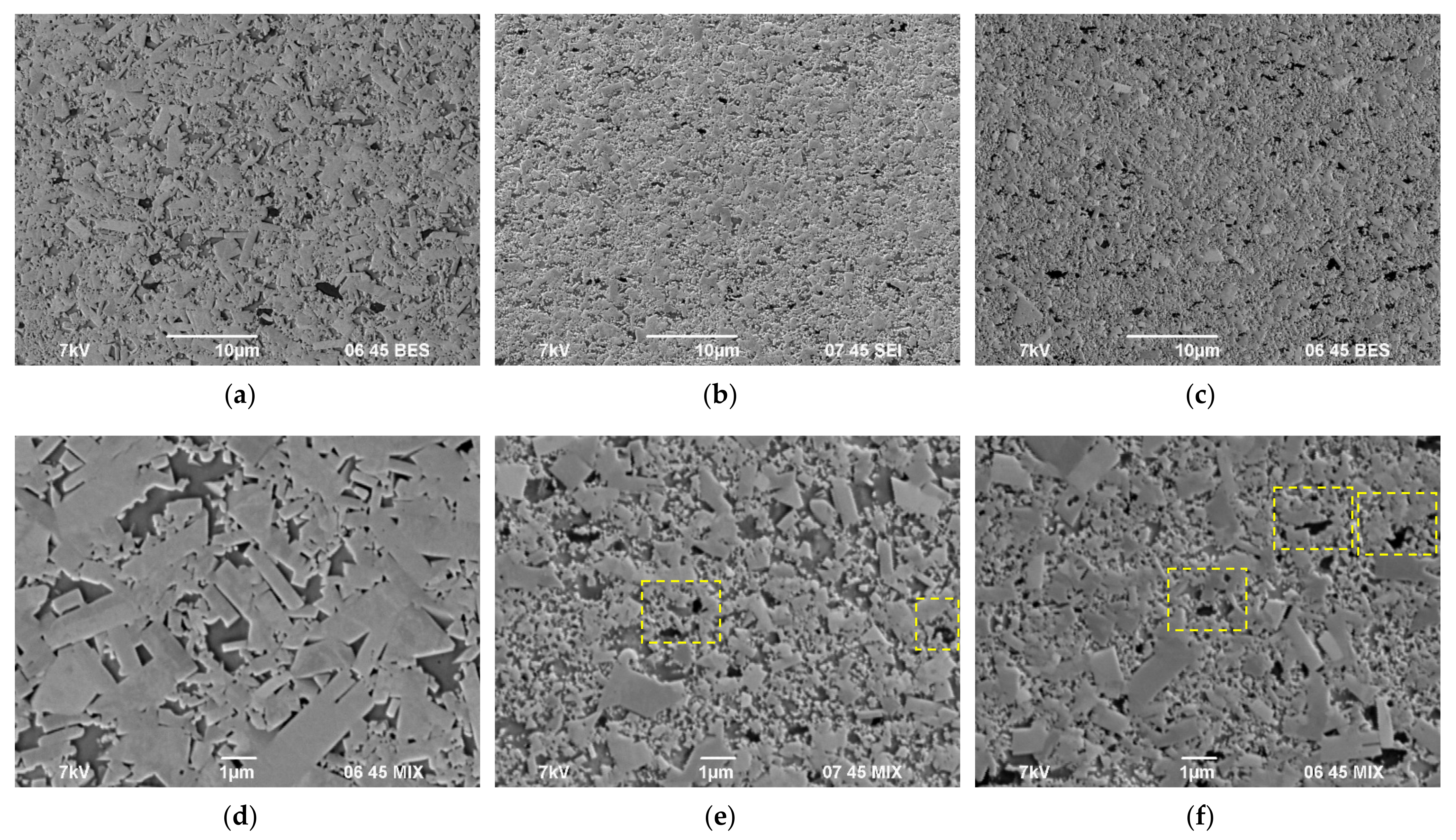
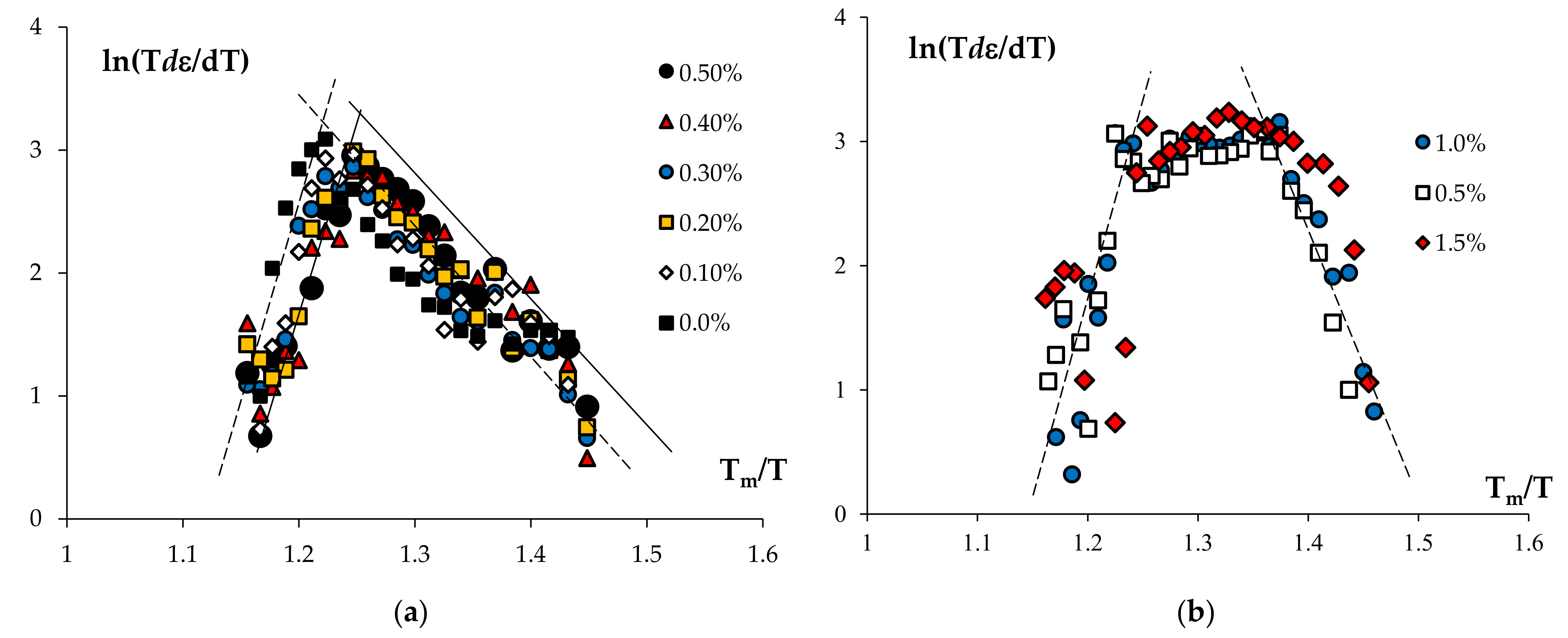


| Powder | Concentration, wt.% | |||||||||||
|---|---|---|---|---|---|---|---|---|---|---|---|---|
| W | C | O | N | Co | Fe | Al | Ti | Mo | Cr | Ta | V | |
| α-WC submicron powder (series #1) | balance | 6.07 | 0.14 | - | <10−3 | 3 × 10−3 | <10−3 | <10−3 | 10−3 | 10−3 | <10−3 | 0.15 |
| α-WC nanopowder (series #2) | balance | 6.36 | 0.75 | 0.06 | <10−3 | 9.6 × 10−5 | 1.9 × 10−4 | - | 5.4 × 10−5 | 2 × 10−5 | - | - |
| β-Co powder | - | 0.12 | 0.41 | 0.04 | balance | 2.2 × 10−3 | - | - | - | - | - | - |
| Graphite Concentration, wt.% | Series 1 Powder | Series 2 Powder | ||||||||
|---|---|---|---|---|---|---|---|---|---|---|
| ρ/ρth, % | d, μm | fη, wt.% | T1, °C | T2, °C | ρ/ρth, % | d, μm | fη, wt.% | T1, °C | T2, °C | |
| 0 | 99.6 | 0.4–0.5 | 8 | <800 | 1100 | 100.2 (*) | 0.1–0.5 | >40 | 850 | 1050 |
| 0.1 | 99.7 | 0.4–0.5 | 6 | <800 | 1100 | - | - | - | - | - |
| 0.2 | 99.5 | 0.4–0.5 | 0 | <800 | 1080 | - | - | - | - | - |
| 0.3 | 99.4 | 0.4–0.5 | 0 | <800 | 1060 | - | - | - | - | - |
| 0.4 | 99.5 | 0.4–0.5 | 0 | <800 | 1060 | - | - | - | - | - |
| 0.5 | 99.3 | 0.4–0.5 | 0 | <800 | 1040 | 100.0 | 0.1–0.5 | 33 | 850 | 1025 |
| 1.0 | - | - | - | - | - | 98.6 | 0.1–1 | 14 | 820 | 1000 |
| 1.5 | - | - | - | - | - | 96.3 | 0.1–5 | 0 | <800 | 990 |
| Graphite Concentration, wt.% | Mechanical Properties (1) | |||
|---|---|---|---|---|
| Series #1 | Series #2 | |||
| Hv, GPa | KIC, MPa·m1/2 | Hv, GPa | KIC, MPa·m1/2 | |
| 0 | 18.6 | 5.9 | 19.5–20 (2) | 5–6 (2) |
| 0.5 | 20.9 | 5.4 | 19.3 | 5.7 |
| 1.0 | - | - | 19.5 | 7.7 |
| 1.5 | - | - | 19.4 | 8.0 |
| Graphite Concentration, wt.% | Activation Energy Qs(I), kTm (±2.5 kTm) | Activation Energy Qs(II), kTm (±2 kTm) | ||
|---|---|---|---|---|
| Series 1 | Series 2 | Series 1 | Series 2 | |
| 0 | 10 | 14 | 34 | 18 |
| 0.1 | 11 | - | 30 | - |
| 0.2 | 9 | - | 16 | - |
| 0.3 | 8 | - | 17 | - |
| 0.4 | 9 | - | 14 | - |
| 0.5 | 9 | 8 | 13 | 25 |
| 1.0 | - | 7 | - | 20 |
| 1.5 | - | 8 | - | 12 |
Publisher’s Note: MDPI stays neutral with regard to jurisdictional claims in published maps and institutional affiliations. |
© 2021 by the authors. Licensee MDPI, Basel, Switzerland. This article is an open access article distributed under the terms and conditions of the Creative Commons Attribution (CC BY) license (https://creativecommons.org/licenses/by/4.0/).
Share and Cite
Lantcev, E.; Nokhrin, A.; Malekhonova, N.; Boldin, M.; Chuvil’deev, V.; Blagoveshchenskiy, Y.; Isaeva, N.; Andreev, P.; Smetanina, K.; Murashov, A. A Study of the Impact of Graphite on the Kinetics of SPS in Nano- and Submicron WC-10%Co Powder Compositions. Ceramics 2021, 4, 331-363. https://doi.org/10.3390/ceramics4020025
Lantcev E, Nokhrin A, Malekhonova N, Boldin M, Chuvil’deev V, Blagoveshchenskiy Y, Isaeva N, Andreev P, Smetanina K, Murashov A. A Study of the Impact of Graphite on the Kinetics of SPS in Nano- and Submicron WC-10%Co Powder Compositions. Ceramics. 2021; 4(2):331-363. https://doi.org/10.3390/ceramics4020025
Chicago/Turabian StyleLantcev, Eugeniy, Aleksey Nokhrin, Nataliya Malekhonova, Maksim Boldin, Vladimir Chuvil’deev, Yuriy Blagoveshchenskiy, Nataliya Isaeva, Pavel Andreev, Kseniya Smetanina, and Artem Murashov. 2021. "A Study of the Impact of Graphite on the Kinetics of SPS in Nano- and Submicron WC-10%Co Powder Compositions" Ceramics 4, no. 2: 331-363. https://doi.org/10.3390/ceramics4020025
APA StyleLantcev, E., Nokhrin, A., Malekhonova, N., Boldin, M., Chuvil’deev, V., Blagoveshchenskiy, Y., Isaeva, N., Andreev, P., Smetanina, K., & Murashov, A. (2021). A Study of the Impact of Graphite on the Kinetics of SPS in Nano- and Submicron WC-10%Co Powder Compositions. Ceramics, 4(2), 331-363. https://doi.org/10.3390/ceramics4020025








